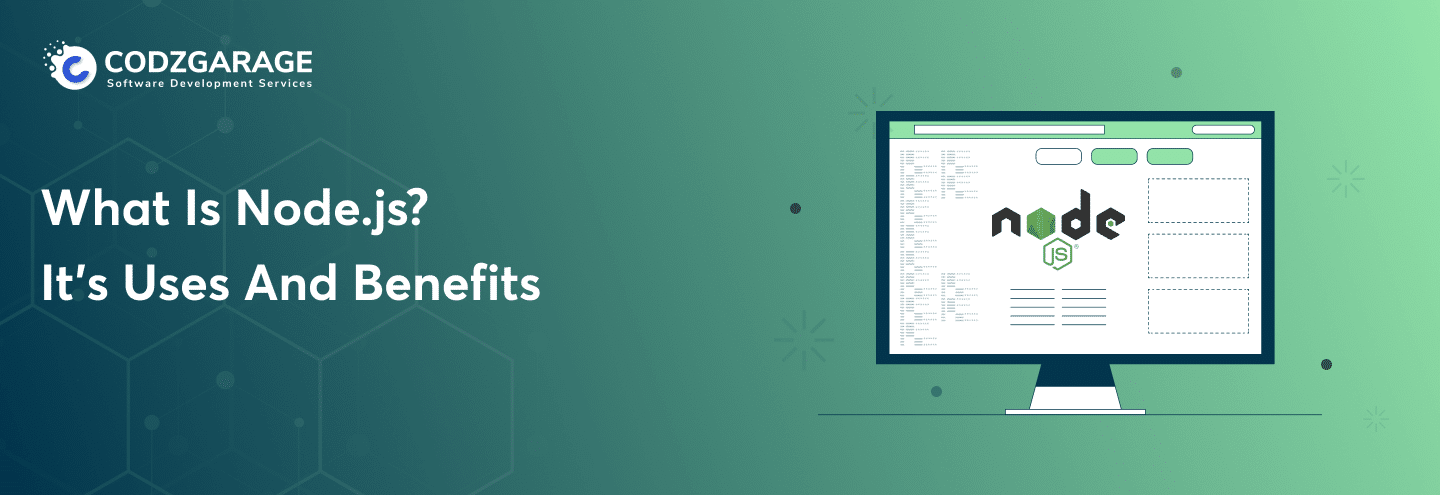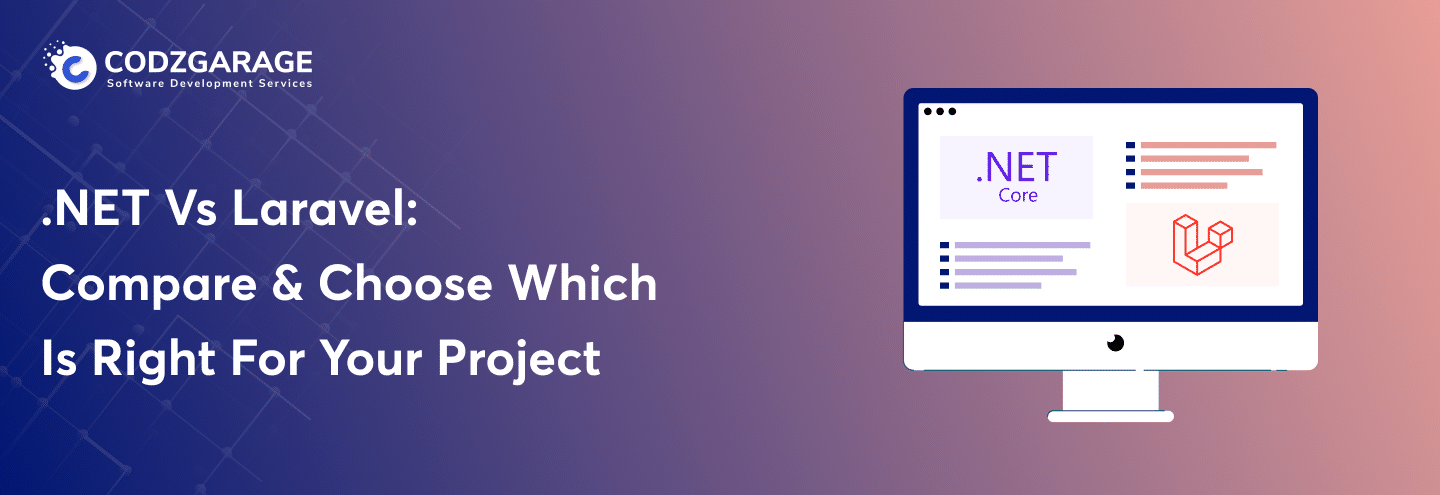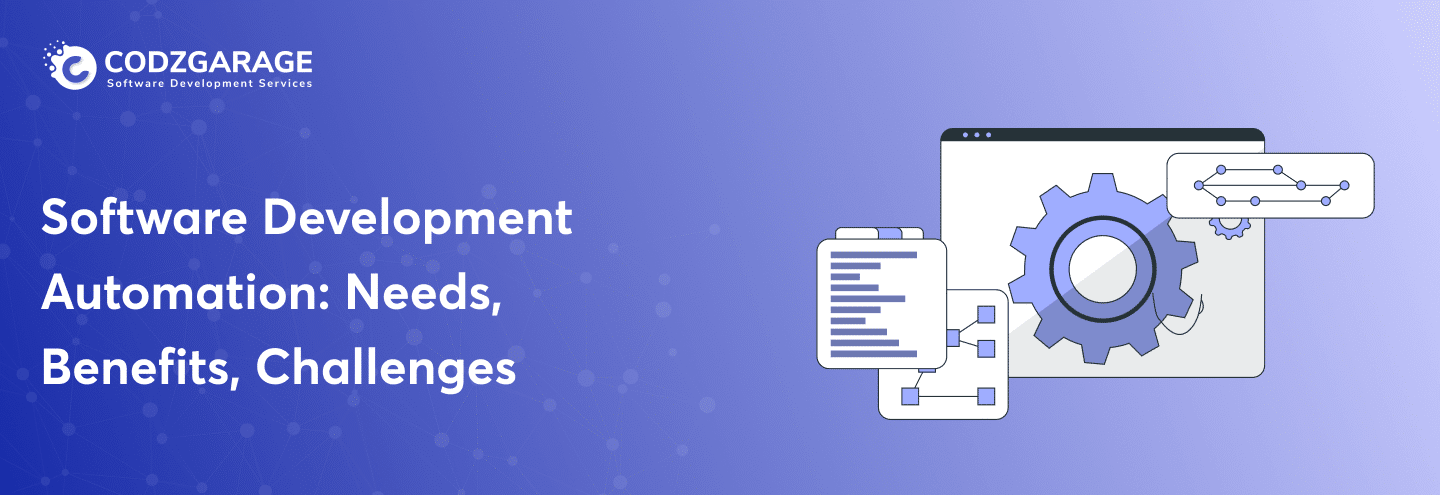Best Front-end Frameworks for Web Development In 2023
When it comes to web development, knowing the right frameworks will help you make better web applications relevant to your business. You cannot select random frameworks and build your web application. You need to compare each framework and match it with your requirement. This guide will help you do it.
No matter how well-developed the back end of your website is, the front-end frameworks have a lot to do with the user experience. In order to meet the user’s expectations, you need to build your web front-end as impressive as a dream come true. Pondering how? This article on frontend frameworks for web development in 2024 will help you get there!
It takes no above 50 milliseconds for a user to make their opinion about a website. Got flabbergasted? There’s nothing to worry about–as you can create a compelling website design. All you need is to explore some front-end frameworks that will remedy the obstacle and create the best UI for your website.
It’s needless to say that the back-end and front-end of a website are interdependent on each other. But, the front end of a website is something a user encounters first; afterward, the back end comes into play, propelling the need for the front end to be appealing.
There may be just one framework suitable to your project requirement but we are masters of all. Whether you are looking for Angular app developmentReact.JS development, or others, we have expertise and experts for all. Let’s connect.
Having a right web development framework is as crucial as picking the right agency for web development. However, a wide array of frameworks available may mystify you when selecting one of them. Therefore, we’ve brought this article that involves 12 front-end frameworks for web development to build you an attractive and interactive UI for your website in 2023. Let’s explore!
But, before we head up to further assessment, why not have an eye on the basics first? So, here we go;
What is Front-End Framework?
A front-end development framework is a kind of software that allows developers to utilize pre-written code modules to develop the front end for mobile, web apps, and websites. These frameworks are the amalgamation of fundamental software modules and built-in features, enabling developers to create a variety of websites without requiring them to write codes from scratch.
Recently we wrote an article on mobile development frameworks, which went well with our users and readers, giving us an opportunity to explore web development frameworks. Besides, they specify the rules for building the website’s architecture–as you have a skeleton that you can alter as per the requirements. Some of the front-end framework examples are React, Vue.js, Angular, Backbone js, jQuery, and so on.
Besides, they specify the rules for building the website’s architecture–as you have a skeleton that you can alter as per the requirements. Some of the front-end framework examples are React, Vue.js, Angular, Backbone js, jQuery, and so on.
Codes libraries, scripting languages, utility programs, and other software that offers the development and implementation of numerous components of large projects are the best examples of frameworks. Front-end frameworks are the tools/platform/product that serves just like a foundation used for the advancement of the front-end components of web solutions.
Why Use Frontend Frameworks for Web Development?
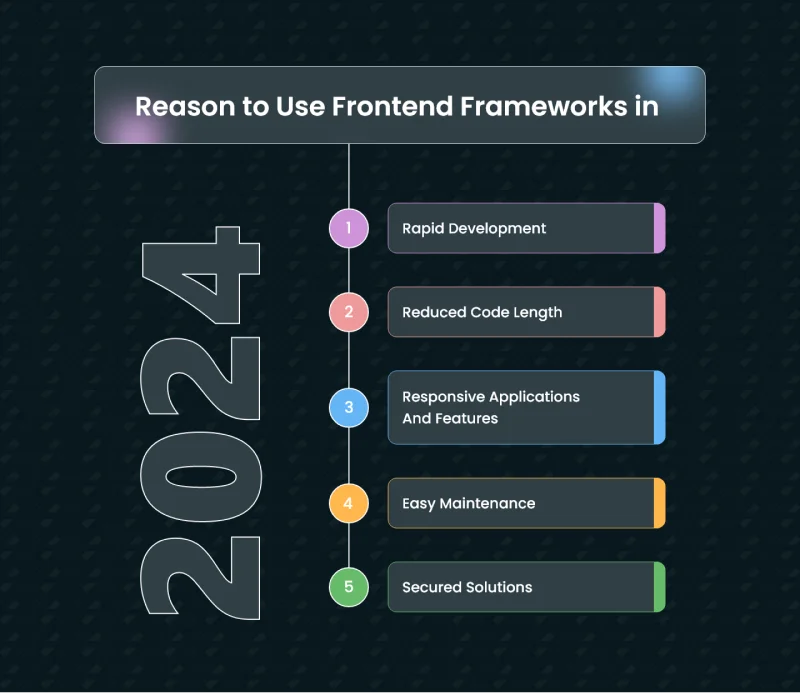
Front-end is what users encounter prior to anything else when they come to a website, and this’s what makes front-end web design of utmost importance. Front-end development frameworks ease the process of reusing the codes along with maintaining and upgrading them over time.
They assist you in improving the overall performance of your website while making it convenient to create responsive designs that function well on mobile devices. Moreover, using a framework can also assist you in curtailing the time you need to write the codes and update them, making the web development process faster and more efficient.
Advantages Of Front-End Frameworks
It would be best if you considered some of the advantages of the Frontend web framework. Let’s have a look!
Rapid Development
Faster development ensures users get quick and faster results. Reusable components and templates shorten the time associated with development. This further allows updating specific pages without changing the entire design and streamlines the app launch. Besides, front-end frameworks capacitate developers to use bug-free libraries; hence, they can save the time invested in finding and fixing bugs.
Reduced Code Length
The reduced code length of frameworks is the second advantage. With the content approach, the frameworks divide the code into modules that help developers reduce the time and effort invested in development by reusing once-development components wherever they are needed.
Responsive Applications And Features
There are front-end frameworks that allow web developers to develop applications with responsive features. They are adaptable and streamlined in construction, enabling the website to respond quickly with a single tap.
Easy Maintenance
Ease of maintenance is another advantage of using frameworks. They break applications into multiple reusable components to ease changes without affecting the entire application. Using matching design patterns enables newbie developers to develop and maintain apps conveniently.
Secured Solutions
Frontend web development frameworks are relatively secure. When cyber crawlers are looking for loopholes to attack your website, it protects your website from being attacked. With this advancement, you can expect a free, more secure web browsing experience.
What Are The Solutions You Can Create Using UI Frameworks?
There are a wide variety of excellent front-end development frameworks for web development that front-end web developers use to cater to their different requirements relating to web development. Developers can utilize front-end development frameworks for creating solutions that open in a browser, for instance, web applications, websites, web services, and so on. However, you will experience the output when you choose the right partner.
However, you will experience the output when you choose the right partner. In our previous article, we suggested some tips for selecting a suitable web development company.
Top 12 Frontend Frameworks For Web Development In 2024
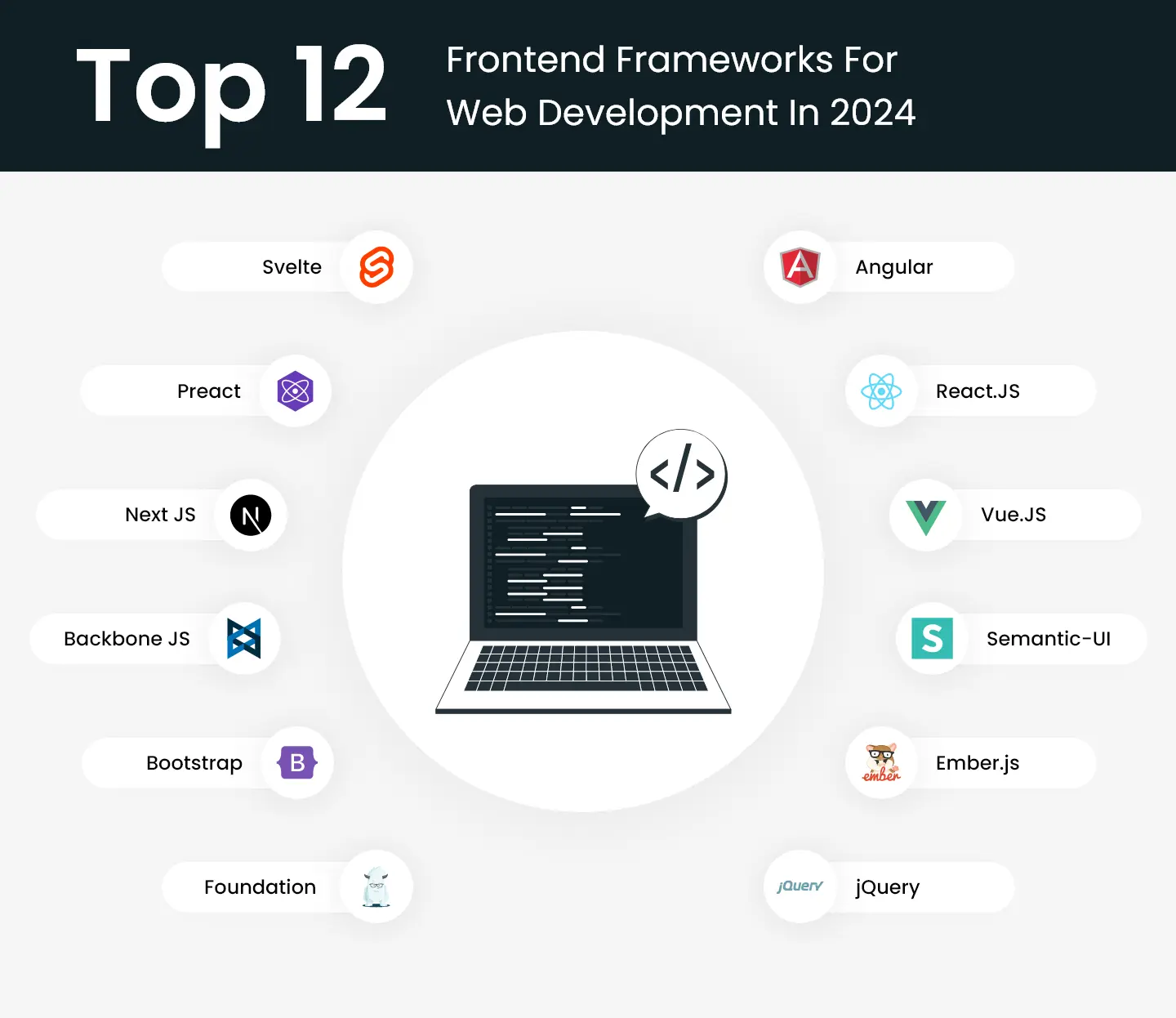
Here’s a comprehensive list of the best frameworks for front-end development in 2024. Let’s have an eagle eye on them so that you can be efficient in choosing the right one for your next project.
Angular
The first in the list, Angular, is one of the most popular front-end frameworks used by front-end web developers. It’s a typescript-based front-end development framework built by Google. One of the best front-end frameworks is Angular, which outclasses its rivals. The component-based framework enables developers to create efficient, scalable, and state-of-the-art single-page web applications. It’s a tool for developers to create, test, and modify codes and a collection of well-integrated libraries.
Angular enables developers to scale single-page applications to enterprise-level applications as per their business needs. The framework is embellished with many features, making it one of the most popular frameworks for web front-end development.
React
The next one on this list is React. Built and backed by Facebook, the framework is easy to learn and used to fix issues relating to code maintainability. Being developed by Facebook, React has excellent functionality for virtual DOMs. If you want rich traffic with a stable platform to handle, Hire Reactjs developers and build your preferred web applications. The framework is ideal for PWA and SPA.
Many reputed organizations, including PayPal, Uber, Microsoft, Facebook, LinkedIn, eBay, Netflix, Google, and so on, use React for the next level of experience.
Vue.js
One of the most popular front-end frameworks, Vue is an approachable and versatile framework for building web user interfaces. It’s a state-of-the-art progressive MVVM framework that takes pluses of incremental adoption to the greatest extent possible. As one of the best JavaScript libraries, the framework creates a lightweight and easy-to-use interactive UI elements.
Furthermore, Vue.js offers data-reactive elements via a flexible and straightforward API.
Vue.js is small in size, hence convenient to install and download. With this framework, you can create small and large-level templates and identify errors in no time. This is what saves you an immense amount of time associated with the development.
Semantic-UI
Now, we’ve Semantic-UI the next on the list. The framework was launched in 2014 and is still new to the market. Semantic-UI is a CSS framework developed by full-stack developer Jack Lukic. jQuery and LESS are utilized to power Semantic-UI. The front-end framework rose to the top of the Javascript projects on GitHub in 2015 and later. Snapchat, Ovrsea, Digital Services, Accenture, and many others use Semantic-UI.
Rich and responsive UI, a great collection of themes, self-explanatory organic code, and so on are some of the pluses of Semantic-UI.
Ember.js
Another open-source front-end framework for the web is Ember.js which we will look at next. It assists developers in creating innovative user interfaces for web, mobile, cross-platform, and desktop applications. The framework further adheres to the MVVM pattern and creates a testing program by default for each helpful feature. When you choose to use Ember.js, you can rely on its ever-expanding community of talented developers to constantly release and improve new features.
Some of the reputed firms like Netflix, Apple Music, Tinder, PlayStation, and so on make use of Ember.js. Consistent documentation, native testing, debugging tools, two-way data binding, capability to support TypeScript, JavaScript, and so on are some of the pros of this front-end framework.
jQuery
An American software engineer and entrepreneur, John Resig, built jQuery. It’s one of the ancient front-end development frameworks that’s still popular amongst front-end web developers. The framework is one of the cross-platform libraries intending to make client-side HTML scripting way more convenient. An API capable of working across a wide array of web browsers enables jQuery to make tasks such as handling documentation, Ajax animation, and manipulation easier.
jQuery is used by Uber, Twitter, Bank of America, and so on. Some of the prose of this framework is the streamlined procedure of sending HTTP requests, the capability to allow dynamic content, and many more.
Foundation
It’s a robust front-end framework explicitly designed to assist developers in prototyping and developing websites in a reduced amount of time. The framework involves CSS and HTML components, Saas variables, JavaScript plugins, and other functionalities needed to create innovative web applications.
Foundation focuses on the creation of prototypes rather than the production of codes. It allows developers to move from a design to functional prototypes without spending time on writing codes. Want to build a visually appealing, mobile-friendly website embellished with personalized experience? Foundation would be the right choice for you.
Organizations, including eBay and Firefox, leverage the advantages of this framework. Customized user experience for various platforms, HTML5 for validation libraries, Flexible grids, and so on are some of the pluses of Foundation.
Bootstrap
The next one is Bootstrap, that’s an open-source CSS framework that allows responsive, mobile-first, front-end web development. Developed and customized by Saas, the framework utilizes a built-in grid system and components to bring your ideas to life using JavaScript plugins. The framework helps you create responsive formats and interfaces, incorporating CSS and HTML configuration formats and building an exceptionally responsive website.
Being highly responsive, compatible, and offering rapid development are advantages you can leverage using Bootstrap.
Backbone JS
Backbone is the next one on the list. It’s a popular JavaScript library that helps you structure a website appropriately by offering models embedded with customized events and key-value binding. Backbone.js is suitable for developing single-page applications and keeping numerous aspects in sync. Developers can utilize predefined perspectives by using the Backbone Layout Manager, which offers a straightforward solution to the obstacles dealt with by developers.
Pinterest, Uber, Linkedin, Roblox, Master Card, and Walmart use this framework to enhance their front-end development experiences. 100+ available extensions, beginner-friendly, well-organized in-depth tutorials, and so on are some of the beneficial facets of Backbone.js.
Next JS
We have Next.js; the next that’s the first choice of front-end web developers. It was developed dating back to 2016 by Guillermo Raunch, Vercel CEO. Next.js is an open-source JavaScript framework that allows developers to create unmatched, user-oriented, high-performance websites that work well and deliver expected outcomes. This straightforward front-end framework allows developers to build websites through automatic static optimization that puts static and dynamic attributes together. Besides, Next.js is preferred because of its search engine optimization (SEO) support.
Well-known websites, including TikTok, Twitch, Hashnode, and many others, use Node.js for front-end development. Enhanced performance, better SEO, easy upgrades, automated code splitting, and so on are some of the pluses of node.js.
Preact
Although React is considered one of the best and most popular frameworks for front-end development, it isn’t free from flaws, which is the root cause behind the existence of Preact. Intending to bridge the gap between requirements and missing features of React arose the concept of Preact. It’s a tiny version of React. Both React and Preact have equal APIs and use the same application development methodology. If you have a small project with no complex integration, Preact is a good choice. But if your project needs many features, choosing this framework can be a wise decision.
Svelte
Now, we have Svelte, the next one on the list. However, this framework was built by Rich Harris in 2017; it’s in its early stages. It’s a state-of-the-art JavaSctript compiler designed to develop high-end user interfaces. The framework doesn’t employ virtual DOM; instead, it uses a specific JavaScript Virtual Machine designed to build user interfaces. This enables Svelte to be ten times faster compared to other frameworks such as Angular and React.
If you have a large project, you’re advised not to use Svelte– as it isn’t comprehensive, and you might have to deal with issues when finding necessary assistance and tools from its limited community. Chess, Cashfree, Philips, BlueHive, and so on use this Svelte to cater to their needs.
Perplexed with So Many Options? Connect with us for FREE consultation
Some of the pros of this framework are faster performance than other frameworks, including React and Angular, better reactivity, Scalability, simplicity, lightweight, and the capability to use existing JavaScript libraries.
Wrapping Up:
However, we have mentioned above the most popular ones; no front-end development framework is one-size-fits-all for every project. All have their own pros and cons, and the one that fits another’s project might not fit into your project either. Therefore, to select the proper front-end development framework for your web development, you must gauge before hiring web developers or taking any further step. You can also take the support of an expert or software development company to find the right UI frameworks.
Have a front-end development project in hand? You can connect with a web development company like ours to get better help. Let’s Connect for more information.
FAQs
Front-end frameworks ease the hassle for developers in building a website’s user interfaces. Using a framework saves you precious time– as you don’t need to assess what works to design the product you’re creating. The reduced efforts, expense, and time we get using frameworks make front-end development frameworks popular.
The time invested in developing a web app mostly depends on your requirements. It can vary from project to project. Generally, a web application takes anywhere between 4 to 5 months to be developed and deployed.
When it comes to the cost of web application development, it can vary depending on the project. The list below shows you an overview of the cost spent on web app development
- Simple web application– $15,000 to $50,000
- Web app with mid-level complexity— $50,000 to $150,000
- Complex web application— $150,000 to $300,000, and sometimes even more.
There is a wide array of front-end frameworks available out there, including React, Vue, Angular, Ember, and so on, but Vue is the simplest one. This is why Vue is the most popular one. It’s a two-way framework that’s smaller in size and well-known for two features: Component-based and Visual DOM. Apart from Vue, Backbone and jQuery are the front-end frameworks written in JavaScript that offer convenient front-end development.
Virtual DOM implementation and rendering enhancements make React better than Angular. Version migration capabilities of React are highly straightforward– unlike Angular, you needn’t install updates one at a time. Besides, with React, developers have access to a massive range of pre-existing solutions.
Want to
Hire Web DevelopersOur Expertise
- Dedicated team
- Collaborative
- Skilled




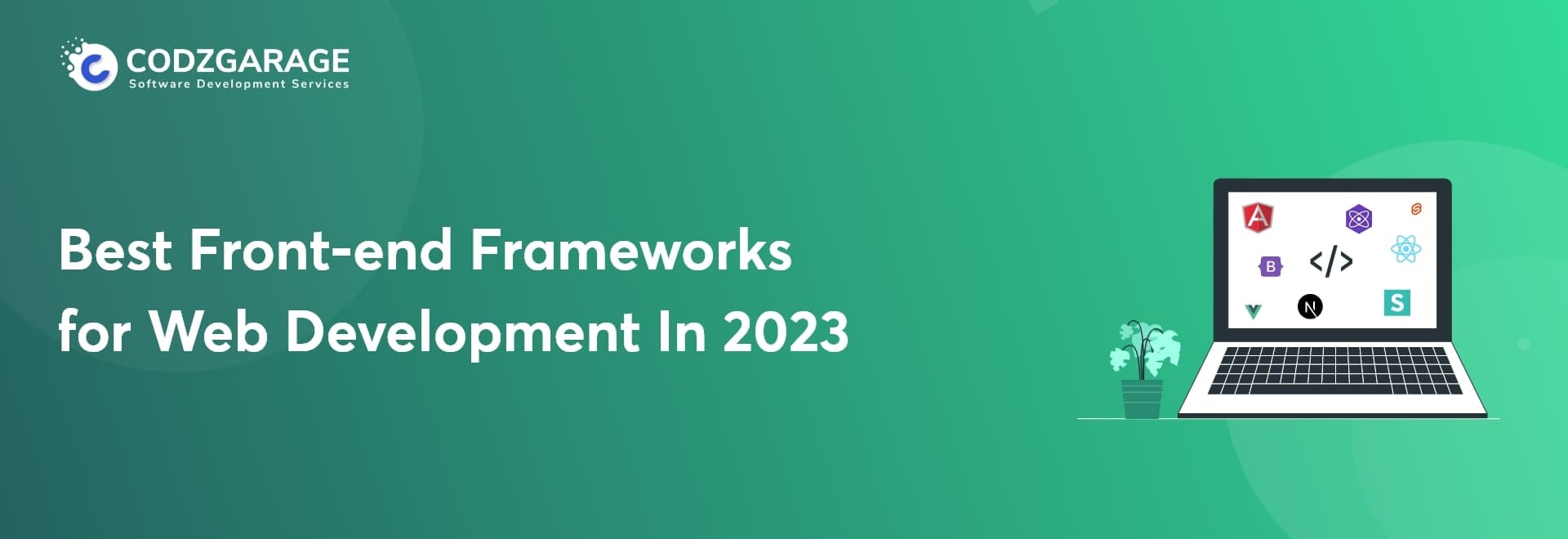


 Kevin Bhut
Kevin Bhut 